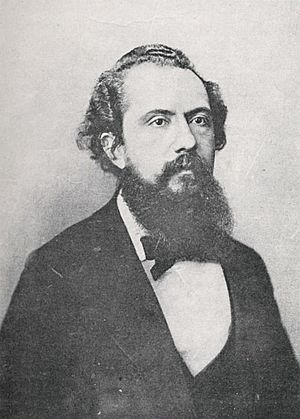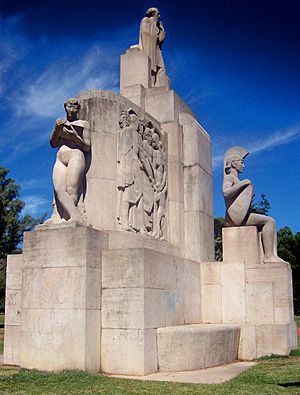Nicolás Avellaneda facts for kids
Quick facts for kids
Nicolás Avellaneda
|
|
|---|---|
 |
|
| National Senator | |
| In office May 3, 1882 – November 25, 1885 |
|
| Constituency | Tucumán |
| In office May 3, 1884 – October 10, 1884 |
|
| Constituency | Tucumán |
| President of Argentina | |
| In office October 12, 1874 – October 11, 1880 |
|
| Vice President | Mariano Acosta |
| Preceded by | Domingo F. Sarmiento |
| Succeeded by | Julio A. Roca |
| Minister of Justice and Public Instruction | |
| In office October 12, 1868 – August 10, 1873 |
|
| President | Domingo Faustino Sarmiento |
| Preceded by | Eduardo Costa |
| Succeeded by | Juan Crisóstomo Albarracín |
| Personal details | |
| Born | October 3, 1837 San Miguel de Tucumán, Tucumán |
| Died | November 24, 1885 (aged 48) At sea |
| Nationality | Argentine |
| Political party | National Autonomist Party |
| Spouse | Carmen Nóbrega Miguens |
| Profession | Lawyer |
Nicolás Remigio Aurelio Avellaneda Silva (born October 3, 1837 – died November 24, 1885) was an important Argentine politician and journalist. He served as the President of Argentina from 1874 to 1880. During his time as president, Avellaneda focused on improving banking and education. These changes helped Argentina's economy grow a lot. Two big events during his presidency were the Conquest of the Desert and making Buenos Aires a special federal district.
His grandson, José Domingo Molina Gómez, later became president when Juan Perón was captured.
Contents
Who Was Nicolás Avellaneda?
Nicolás Avellaneda was a key figure in Argentina's history. He worked to make the country stronger and more modern. His ideas about land and education helped shape Argentina for the future.
Early Life and Education
Nicolás Avellaneda was born in San Miguel de Tucumán. When his father, Marco Avellaneda, died during a revolt, his mother moved with him to Bolivia. He later studied law in Córdoba. Even though he did not finish his degree there, he gained a lot of knowledge.
Starting a Career
After returning to Tucumán, Nicolás started a newspaper called El Eco del Norte. In 1857, he moved to Buenos Aires. There, he became the director of El Nacional and an editor for El Comercio de la Plata. He finished his law studies in Buenos Aires.
He met Domingo Faustino Sarmiento, who later became president. Sarmiento helped Avellaneda become an economics teacher at the University of Buenos Aires. Nicolás also wrote a book called "Estudio sobre las leyes de tierras públicas" (Study of the laws about public lands). In this book, he suggested giving land to farmers who would use it for production. This idea was similar to systems used in the United States. He believed it would help create stable communities and grow the population.
Becoming President
Before becoming president, Avellaneda was a member of the house of representatives in 1859. In 1866, he became the Minister of Government for Adolfo Alsina in Buenos Aires province. During Domingo Faustino Sarmiento's presidency, Avellaneda served as Minister of Justice and Education. He made important changes to the education system that defined his time in that role.
In 1874, Nicolás Avellaneda became president. However, some people, like Bartolomé Mitre, questioned if his election was fair. Mitre even used the army against Avellaneda. But Mitre's forces were defeated by Julio Argentino Roca. Avellaneda chose to forgive Mitre to help bring peace to the country. He also included some of Mitre's supporters in his government.
Growing Argentina's Economy
Avellaneda believed that people from Europe were important for Argentina's growth. Like Alberdi and Sarmiento, he thought immigration would help the country develop. He created the "Avellaneda law," which made it easier for European farmers to get land. Because of this law, the number of immigrants doubled in just a few years.
After bringing peace to the country, Avellaneda faced a big economic problem. He focused on controlling land through the Conquest of the Desert. He also worked to expand railroads and increase exports of cereals and meat. These efforts helped Argentina's economy.
Important Changes During His Time
During his presidency, Argentina's economy was affected by a crisis in Europe. This crisis almost caused Argentina to default on its debts. Avellaneda was determined to pay off the country's debts. He famously said that Argentines would "economize even to their hunger and thirst" to keep their promises to foreign markets. He cut government spending and put in place some protective trade rules. The economy eventually recovered thanks to growing exports of refrigerated meat to Europe. This was a new way to transport meat at the time.
Life After the Presidency
Nicolás Avellaneda was 37 years old when he became president, making him the youngest Argentine president ever elected. He was also a very active writer, and his works have been published in 12 volumes.
He had served in the Argentine Senate for five months in 1874. After his presidency, he returned to the Senate in 1883. He served there until his death in 1885. Nicolás Avellaneda died on a ship while returning from medical treatment in France.
See also
 In Spanish: Nicolás Avellaneda para niños
In Spanish: Nicolás Avellaneda para niños


